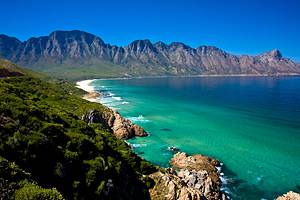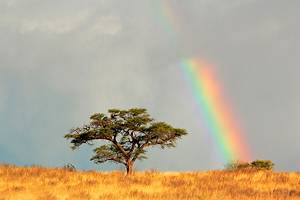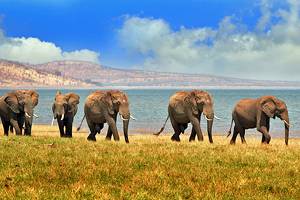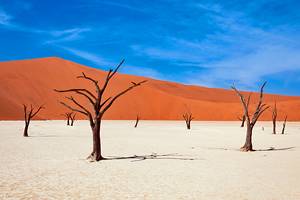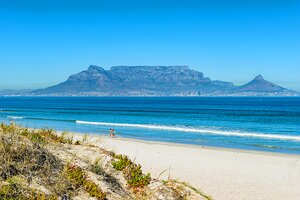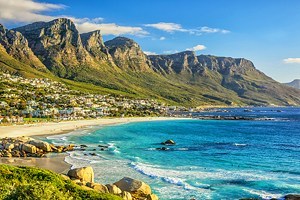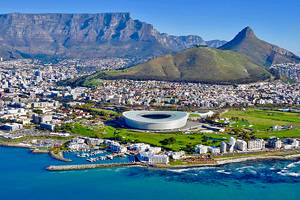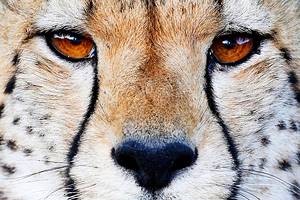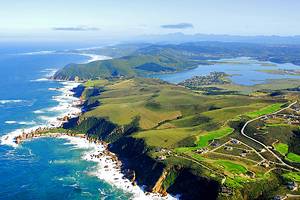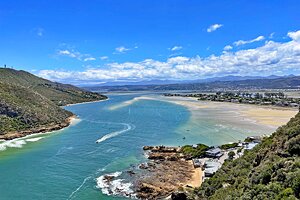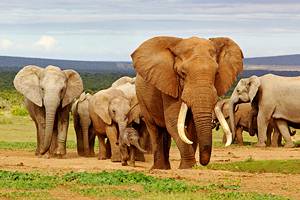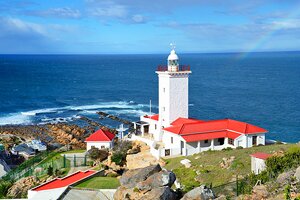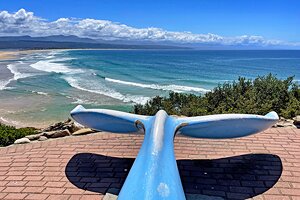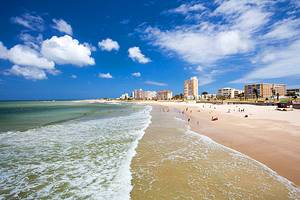Tourist Attractions in the Northern Cape
Steeped in stark, semi-desert beauty, the Northern Cape province is the largest of all the South African provinces and the most sparsely populated. This is a place to find solitude in a land of big skies and bold hues. From the red earth and golden grasses of the Kgalagadi (Kalahari) Transfrontier Park, one of the world's largest wilderness areas, to the kaleidoscopic wildflowers of Namaqualand and the deep blue, cloudless skies of Kimberley, once the diamond capital of the world, the region serves up striking vistas.
At Augrabies Falls National Park, travelers can watch the Orange River plunge into a gaping gorge at the world's sixth largest waterfall. In the desert, black-maned Kalahari lions and quirky quiver trees eke out a living on the scorching plains. And the province is also rich in history; visitors can tour historic battlefields, as well as Victorian villas where mining magnates once mingled during the country's illustrious diamond rush days.
Discover the best things to do in this rugged region with our list of the top attractions in the Northern Cape.
Kgalagadi (Kalahari) Transfrontier Park

In 2000, South Africa's Kalahari Gemsbok National Park and Botswana's Gemsbok National Park merged, creating one of the largest wilderness areas in the world-more than 3.6 million hectares. Cornflower blue skies, russet red dunes, and golden grasslands provide a striking canvas for photographic safaris in this harsh, arid region.
Wildlife is abundant and easily viewed thanks to the scant vegetation here. Beautiful black-maned Kalahari lions are the most iconic animal in this region, and the park also protects leopards; cheetahs; gemsbok; meerkats; and many species of birds, including sociable weavers, with their giant nests, and birds of prey.
Accommodation ranges from campsites to comfortable chalets. Four-wheel drive vehicles are recommended for some of the rugged tracks here.
Official site: http://www.sanparks.org/parks/kgalagadi/
Goegap Nature Reserve, Namaqualand

In the big-sky semi-desert of Namaqualand, Goegap Nature Reserve offers fun 4WD tracks and stunning displays of wildflowers in the spring. This 15,000-hectare reserve is worth visiting even when the wildflowers aren't in bloom. The vegetation is typical of Namaqualand, with succulents; shrubs; and bizarre quiver trees or kokerboom trees, a type of branched aloe.
The park also protects animals that are specially adapted to the parched conditions, including antelopes, the endangered Hartmann's zebra, aardwolf, honey badgers, and more than 94 species of birds.
In the spring, the arid landscapes erupt in an impossible blaze of colorful blooms that delight avid photographers. Rainfall and temperature variations influence the types of flowers in bloom, surprising visitors with different color combinations each year.
Besides photography, popular things to do here include hiking on the varied trails, mountain biking, and stargazing at the crystal clear night skies. Campsites and basic accommodation is available within the park.
The Big Hole, Kimberley

The capital of the Northern Cape and once the world's diamond capital, Kimberley lies on the boundary between the Northern Cape Province and the Orange Free State and is a convenient stopover on the road from Cape Town to Johannesburg. Kimberley is known as the Diamond City, as this is the place where the foundations of South Africa's wealth were laid during the heady diamond rush days of the 1870s.
In 1871, prospectors struck it lucky on a farm belonging to the de Beer brothers and on a neighboring hill. Today, that area is known as The Big Hole. The size of eight football fields, this is the world's largest man-made hole and one of Kimberley's main tourist attractions. Between 1871 and 1914, 22.6 million tons of earth and rock were excavated from the mine for a yield of 14.5 million carats of diamonds.
Visitors peer down from a viewing platform into the mine, now filled with water, and picture what it was like when thousands of men toiled here, hauling the rock up to the surface with cables. Afterwards, a visit to the Mine Museum takes visitors on a journey back through the heady diamond rush days.
Official site: http://www.thebighole.co.za/
The Kimberley Mine Museum

On the west side of the Big Hole is the open-air Kimberley Mine Museum, a village of almost 50 buildings, some original and some reproductions, representing Kimberley during the diamond rush days. Sightseers can tour some of the houses, which are furnished in the style of the time.
The first church built in Kimberley was the German Lutheran church of St. Martin (1875). Kimberley's oldest house, however, dates only from 1877; it was built of prefabricated parts imported from Britain: a residence of extraordinary luxury at a time when everyone else was living in tents.
Other houses, shops, and workshops line a cobbled street. The Mining Hall displays a collection of photographs and documents from diamond rush days. Opposite, is the Diamond Hall, with a 616-carat diamond, one of the largest uncut diamonds in the world, and the Eureka, the first diamond discovered in South Africa. A restored tramcar from 1913 carries visitors between the Neoclassical City Hall (circa 1899) and the Big Hole and museum.
Augrabies Falls National Park

The Augrabies Falls, near the frontier with Namibia, are one of the country's great natural wonders. Here, the Orange River plunges in a series of cascades almost 150 meters wide into an 18-kilometer granite gorge enclosed by soaring rock walls. In the language of the Hottentots, who held the falls in awe as a sacred place, the name Augrabies means "place of the great noise," and indeed the falls, which rank among the six largest in the world, justify their name.
The national park, established in 1967 to protect the falls, is a region of extreme aridity with sparse vegetation, consisting mainly of euphorbias and kokerboom or quiver trees. Among the animals living here are klipspringer; porcupines; leopards; baboons; vervet monkeys; and more than 140 species of birds, including Verreaux's eagle, which is frequently seen at the falls.
The 26-kilometer-long Klipspringer Hiking Trail through the gorge takes about three days with overnight accommodation in huts. In summer, the trail is closed because of the heat, however this is the best time to see the falls-particularly in late summer when the river swells with water. Other highlights include Moon Rock, and the scenic viewpoints Oranjekom, Ararat, and Echo Corner. Accommodation is available in campsites and well-equipped chalets.
Official site: http://www.sanparks.org/parks/augrabies/
Mokala National Park

About 70 kilometers south-southwest of Kimberley, Mokala National Park protects some of the country's most endangered species, including white and black rhino. Visitors can also see roan and sable antelope, tsessebe, black wildebeest, caracal, aardwolf, giraffe, kudu, oryx, zebra, and many species of birds. Named after the Setswana word for camel thorn, the park's red earth and golden grass-cloaked plains are dotted with these semi-desert trees, as well as dolerite hills, making a beautiful backdrop for photographs.
Besides day and night game drives, visitors can enjoy horseback rides, hiking, and mountain biking here. Accommodation options include safari bungalows, self-catering cottages, and campsites.
Official site: http://www.sanparks.org/parks/mokala/
Tankwa Karoo National Park

Remote and rugged, Tankwa Karoo National Park is a land of haunting beauty. The national park lies near the border of the Northern Cape and Western Cape in one of the county's most arid regions, with stark desert plains and glittering night skies. Satellite phones are handy here.
Wildlife in the park includes red hartebeest, mongoose, oryx, and a diversity of reptiles. Birding is a popular activity, and visitors can take self-guided game drives on the rough and rutted roads. Besides wildlife watching, visitors come here to bounce around on the 4WD tracks, stargaze at the dazzling night skies, and photograph the stunning semi-desert landscapes from scenic viewpoints. A 4WD vehicle is highly recommended. Accommodation includes campsites, self-catering cottages, a lodge, and guesthouse.
Official site: http://www.sanparks.org/parks/tankwa/
Belgravia Historic Walk

Graced by the grand homes of former mining merchants and magnates, Belgravia is the upscale residential area near Kimberley's old diamond mines. Today, visitors can step back in time and see some of these beautiful old Victorian villas on the Belgravia Historic Walk. The walk visits 30 historic sites and begins at the McGregor Museum, which offers a great overview of the area's history, and was the former temporary residence of imperialist Cecil John Rhodes.
Highlights along the walk include Dunluce, an outstanding example of Late Victorian architecture dating from 1897, and Rudd House, once the home of the mining magnate H. P. Rudd, whose father was a friend and business partner of Cecil Rhodes. Both of these houses are attached to the McGregor Museum and can be toured by appointment. In the 13-story Harry Oppenheimer Building (1974), designed by the German architect H. Hentrich, all diamonds found in South Africa are graded.
Also on the tour, the Duggan Cronin Gallery contains a unique collection of photographs of the native people of South Africa, taken by A.M. Duggan Cronin between 1919 and 1939. Some of the traditional tribal rites depicted can never be photographed again.
The William Humphreys Art Gallery opened in 1952 and displays works by Dutch, Flemish, British, and French masters, as well as South African artists.
Quiver Tree Forest

On Gannabos, a farm near the small towns of Loeriesfontein and Nieuwoudtville, the Quiver Tree Forest is the world's largest colony of these bizarre flowering aloes, also known as kokerboom, (aloe dichotoma). Photographers and budding botanists often stop here on the way to Augrabies Falls and the Kalahari to admire these giant aloes, which would look right at home on the pages of a Dr. Seuss book.
Able to store water in its trunk, the quiver tree can live up to 400 years and is perfectly adapted to the arid conditions. Its name comes from the practice of the San (Bushmen) who used to make quivers for their poison arrows from the dried-out hollow branches. Sociable weaver birds often build their huge multi-chambered nests from their branches. The best time to photograph these sculptural trees is when they produce their bright yellow flowers, usually during May, June, and July.
Magersfontein Battlefield & Museum

About 30 kilometers south of Kimberley, the battlefield of Magersfontein is the scene of a British defeat during "Black Week" in the Boer War, l. The site is well signposted, and visitors can view the battlefield and trenches from an observation point and explore the small museum, which screens an audio-visual presentation and displays a collection of weapons and uniforms.
Near the museum, hilltop memorials honor the dead and provide beautiful views over the area. Guided tours provide fascinating details about these historic events and are highly recommended for history buffs.
Ai-Ais Richtersveld Transfrontier National Park

In the northwest corner of the Northern Cape, right on the border with Namibia, is the spectacular and otherworldly Ai-Ais Richtersveld Transfrontier National Park. The most remote national park in South Africa, the landscape here is made up of volcanic mountains, bizarre-shaped trees, heat-baked red sand, and crumbled rocks. It is at once hostile and beautiful and well worth exploring if you like to get off the beaten path.
The Orange River also flows through this park that spans two countries and where it does, you'll find activities from fly fishing to whitewater rafting. This national park is quite remote, however, and getting here requires a 4WD vehicle. Accommodation in the park is also basic and limited. It is best to visit on an organized tour with a company out of Upington.
Upington

On the banks of the Orange River, the vibrant town of Upington serves as the main hub for activities in the region. From here, you arrange safaris to Ai-Ais Richtersveld Transfrontier National Park or try white water rafting or canoeing down the Orange River on a day or overnight trip.
In Upington itself, try a sunset river boat cruise on the Orange River with Sakkie Se Arkie, which has been popular with locals and tourists for decades. Also in Upington is the Kalahari-Oranje Museum, which is home to a life-sized bronze statue of a donkey that was sculpted by Hennie Potgieter to pay respect to the animal that played such an integral role in helping develop the area in the 1880s pioneer days.
Kakamas and the Green Kalahari

The Green Kalahari is a Northern Cape region that is filled with contrasting colors and dramatic landscapes. The aforementioned Augrabies Falls National Park is here, as is the town of Upington. It is also home to small towns like Kakamas.
Originally constructed by the Dutch Reformed Church in 1897, its moniker means "poor pasture" in the Khoi language. This name is not very fitting, however, as the town sits in a lush valley surrounded by vines, cotton, and fields of flowers along the lower Orange River. The town is home to a number of interesting water canals that were hand built in the early 20th century and can still be viewed today.
Riemvasmaak Hot Springs
Riemvasmaak Hot Springs is 57 kilometers outside the town of Kakamas and is one of the coolest remote attractions in the Northern Cape. Set in a deep ravine surrounded by rolling hills and dotted with wild fig trees, it is a gorgeous mountain desert wilderness area. Besides hot mineral spring pools, there are a number of activities you can partake in here. Check out the challenging 4WD trail, or take a hike past the soaring granite cliffs down to the Orange River.
Whatever you choose to do, you'll be able to soak up this magnificent, almost lunar, landscape just 170 kilometers from the Namibian border. There is lodging in simple chalets that can sleep up to eight people and come with cold showers and kitchenettes but no electricity.
Official site: www.riemvasmaak.co.za/riemvasmaak-hot-springs/
Map of Tourist Attractions in the Northern Cape
More Related Articles on PlanetWare.com
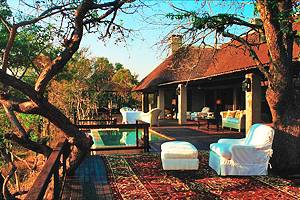
Safari Time: No trip to South Africa is complete without a safari experience. There is nothing like seeing a lion sleeping in the shade of a thorn tree just feet from your open-sided vehicle to make you feel alive and awed at once. Seriously, safaris are magical, and if you have the funds then the best way to do one is in luxury style. But with so much competition it can be difficult to know which lodge and reserve to visit.

Western Cape Wander: Now that you've explored the Northern Cape, it is time to head south to the equally gorgeous Western Cape. This is possibly South Africa's most beautiful province and is home to Cape Town, as well as Africa's southernmost tip, Cape Agulhas, where the Indian and Atlantic Oceans meet. See our Tourist Attractions in the Western Cape article for more on exploring this magnificent province. It will introduce you to the best of the region, including how to chill with penguins and where to watch for whales.


